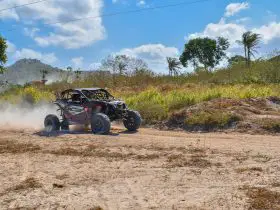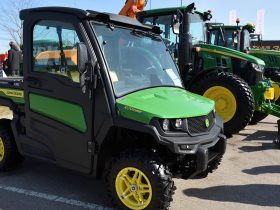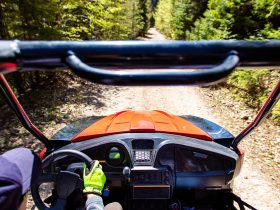Sometimes, our favorite machine is the most simple option.
As a prospective UTV owner, we know that you probably want a machine that is sturdy, dependable, and built with simple yet intelligent technology. You’re not looking for gadgets or frills.
If anything, you’re looking for a machine that can help you get your tasks completed on the weekend, with an added Sunday cruise on the trails.
With so many UTVs on the market, how do you find the right one? Is there one out there that can fulfill your needs while operating on minimal bells and whistles? It’s difficult to compare all of the different brands and offerings when features and specifications are scattered all over the web.
Two basic UTV options—the Yamaha Viking and the Pioneer Mule—each have their own loyal following. Having a hard time deciding which UTV to try? Keep reading for our in-depth comparison of the Yamaha Viking vs Honda Pioneer.
Table of Contents
Yamaha Viking vs. Honda Pioneer Overview
The Utility Terrain Vehicle (also known as a UTV or side-by-side) was brought to market to answer the need for a practical, multi-terrain vehicle that could handle the potential for multiple passengers. They are extremely popular with those who need to perform work around their ranch or rural property, but also provide enough storage space and legroom for a casual drive when the work is over.
Honda Pioneer
Honda first introduced its version of the side-by-side in 2009. Like the Yamaha Viking, the Honda Pioneer is made by an established Japanese manufacturer. This ensures that their products are dependable, affordable, and easy to transition between work and play.
Aesthetically, the Honda Pioneer has a similar look to the Can-Am Defender.
Yamaha Viking
Yamaha (one of many popular Japanese manufactures) released its first UTV model in 2004. After nearly twenty years of UTV design and development, Yamaha has expanded its side-by-side models into the sport category (YXZ Series), the recreation category (Yamaha Wolverine Series), and the utility category.
The main difference between the recreation category and the utility category (the Yamaha Viking vs. Yamaha Wolverine) is size and ability to handle passengers/terrain. The Yamaha Viking is a dependable utility model that is ready to work.
Feature Comparison
While both companies offer safe, dependable UTV designs, each brand has distinct offerings. For the sake of this review, most specs are in reference to the mid-size Pioneer 700 vs. the Yamaha Viking EPS. Special edition models will be noted for education.
Size
Both UTVs come in a wide range of sizes. We’ll break down the variance in the size of a few options below:
Pioneer Rec/Utility Models
- Pioneer 500 – the top-selling entry-level model
- Pioneer 520
- Pioneer 700
- Pioneer 700-4
- Pioneer 1000 – six-speed automatic dual-clutch transmission
Pioneer Special Edition Models
- Pioneer 1000 Special Edition – i-4WD included
- Pioneer 100-5 Special Edition – i-4WD included
Yamaha Viking Three-Passenger Models
- Viking EPS
- Viking EPS Ranch Edition
Yamaha Viking Six-Passenger Models
- Viking VI EPS Engine
Engine
Most Honda Pioneer models run with a class-leading liquid-cooled single-cylinder four-stroke engine. According to Honda, this is the same compact cylinder head found in their motocross bikes.
Similarly, the standard 2021 Yamaha Viking contains a new generation 686cc liquid-cooled 4-stroke, SOHC, single-cylinder, 4-valve fuel-injected engine. The single-cylinder engine results in a dependable work vehicle that excels at lower speeds.
Towing Capacity
The towing capacity will vary in each model. We’ve listed the towing capacity below:
Pioneer Rec/Utility Models
- Pioneer 500 – 1,000 lb
- Pioneer 520 – 1,000 lb
- Pioneer 700 – 1,500 lb
- Pioneer 700-4 – 1,500 lb
- Pioneer 1000 – 2,000 lb
Pioneer Special Edition Models
- Pioneer 1000 Special Edition – 2,000 lb
- Pioneer 100-5 Special Edition – 2,000 lb
Yamaha Viking Three-Passenger Models
- Viking EPS – 1,500 lb
- Viking EPS Ranch Edition – 1,500 lb
Yamaha Viking Six-Passenger Models
- Viking VI EPS – 1,500 lb
With this roundup, you can’t go wrong with any of the Viking or higher-end Pioneer models. If you’re in for serious towing, you may want to consider the investment of a Special Edition Honda Pioneer.
Vehicle Suspension
The suspension of a UTV is an important part to consider, as the comfort and ease of drive can make a huge difference in your work and recreational experience. Both the Honda Pioneer and Yamaha Viking list a dual independent double-wishbone suspension, which means better stability and handling performance. Both excel in this regard, so you should not have to worry about taking passengers over challenging terrain.
Customizability
Both the Honda Pioneer and the Yamaha Viking have optional accessories to customize the look and function of the vehicle. These accessories can be added to your purchase, or customized at a later date.
Honda Pioneer
Individual Honda accessories are available as add-ons to your Pioneer purchase:
- Windscreens
- Bed extenders and accessories
- Fabric doors and roofs
- Hard doors and roofs
- Light enhancements
- Winches
It is important to note that any of the Special Edition Honda Pioneers come with their own accessories package. A la carte add-ons are available for the basic models.
Yamaha Viking
You may purchase additional accessories for your Yamaha Viking:
- A folding windshield
- Heavy-duty front brush guard –
- Highlight brush guard
- A sealed rear window
- Overhead audio system
You’ll want to consider the features that are the most important to you and the vehicle’s intended purpose when comparing the two UTVs.
Affordability and Price
The most popular Honda Pioneers are priced as follows:
- Pioneer 500 – $8,499
- Pioneer 520 – $9,499
- Pioneer 700 – $10,999
- Pioneer 700-4 – $12,399
- Pioneer 1000 – $15,8999
- Pioneer 1000 Special Edition – $21,999
- Pioneer 100-5 Special Edition – $23,999
Check out the official Honda website for additional specs and current prices.
The most popular Yamaha Viking models are priced as follows:
- Viking – $11,999
- Viking EPS – $13,699
- Viking VI EPS – $14,499
- Viking VI EPS Ranch Edition – $15,799
Check out the official Yamaha website for additional specs and current prices.
The Honda Pioneer is an accessibly priced option, with models starting under $10,000. If you’re looking for a simple, bare-bones machine with a dependable track record, this might be a good choice for you.
Though slightly higher-priced, the Yamaha Viking line is competitive, with a slight increase as you go up the line in size. Before making a decision based on price, you will want to look into the features, towing, and passenger capabilities before landing on the right model.
Warranty
With a UTV warranty, the manufacturer guarantees a customer will replace or repair defective parts within a certain time frame.
While all Honda vehicles come with a 1-Year Limited Warranty, customers may purchase an additional four years of coverage with the HondaCare Protection Plan.
A new 2021 Yamaha Viking comes with a 6-Month Limited Factory Warranty and the industry’s first 10-Year Belt Warranty. With the 10-Year Belt Warranty, Yamaha has all Ultramatic automatic transmission builds for ten years.
Pros vs. Cons
For a quick breakdown of the Honda Pioneer 700 vs Yamaha Viking, we’ve compiled some quick pros and cons:
Honda Pioneer
During the hunt for the right UTV, note the pros and cons of the Honda Pioneer.
Pros
- Can spend less than $10k
- HondaCare Protection Plan available
- Trail-ready
Cons
- Limited customizability with basic models
- Limited passenger space
- Depending on the model, only 8.5-10.5 inches of ground clearance– less than other UTVs on the market
- Can be difficult to shift
Yamaha Viking
During the hunt for the right UTV, note the pros and cons of the Yamaha Viking:
Pros
- Comfort – staggered, comfortable seats
- Electric power steering on all EPS models
- Utility side-by-side meets sleek recreational design
Cons
- Single-cylinder engine
- Thin-plastic exterior prone to defects
- A common Yamaha Viking review notes intense vibrations due to speed limiter
Which UTV Is Right for You?
If you are looking for a quiet machine with electric power steering, any model from the Yamaha Viking EPS line would meet your needs. Its sleek build and smooth suspension work make it a great crossover recreational vehicle. The Viking EPS Ranch Edition is one of the best double-row UTVs on the market, providing ample leg space for extra riders while getting the job done. In summary, Yamaha Viking reviews are typically very positive.
If it’s quiet efficiency that you want, the Honda Pioneer is your pick. Most models were built specifically to fit inside of a truck bed, which allows you to easily transport your new UTV to the trailhead. While they are not as quick to release the newest features or invest in advancements as their competition, Honda vehicles are known to last, with the appropriate amount of maintenance.
Both UTVs are dependable Japanese vehicles with great track records and a loyal following.
We hope that you feel a little more confident with our Yamaha Viking vs Honda Pioneer breakdown. If you’re interested in learning about other UTV options, read more about the Yamaha Viking vs. Polaris Ranger 2021.








